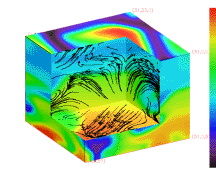
Objective: Our goal is to understand convection in the solar envelope: its role in transporting energy and angular momentum, in generating the solar magnetic field, in providing energy to heat the solar chromo-sphere and corona, in exciting p-mode oscillations and in modifying their resonant frequencies. We plan to achieve this understanding by analyzing simulations of hydro-dynamic and magnetohydrodynamic convection.

Approach: Computational Fluid Dynamics (CFD) is inherently parallelizable, because the same operations are performed on all interior points. We solve the equations of mass, momentum and energy conservation, the induction equation and the equation for LTE radiative transfer. Boundary conditions are imposed by specifying variables in "ghost" zones outside the computational domain.
Accomplishments: We have developed codes in FORTRAN 77 and FORTRAN 90 to efficiently simulate compressible convection on parallel and vector computers and the visualization tools needed to analyze the results. These codes have been used on the TMC CM5, Cray C90, Convex 3880, and SGI Challenge to simulate a small segment of the upper solar convection zone on a 253 x 253 x 163 grid (resolution of 25 km) to study effects of decreased diffusion on the structure and evolution of granules and the down drafts that penetrating into the interior. They are also used to simulate the deep layers of the convection zone and the stable layers below it to investigate penetrative mixing, the role of differential rotation, the pumping of magnetic flux to the stable layer below the convection zone and the diffusion of magnetic flux at the solar surface.
Significance: Understanding the effects of convection on p-modes will improve our ability to probe the solar interior using helioseismology. Storage of magnetic flux below the convection zone and diffusion of flux at the solar surface are important ingredients in the solar cycle dynamo, which influences the Earth's weather and ozone layer. Transport of angular momentum and mixing into the stable interior effect the evolution of stars.
Status/Plans: We will decrease the diffusion and dispersion in our FORTRAN 77 code by switching from third order spline derivatives to compact sixth order derivatives. We will continue both the high resolution realistic simulation of the upper solar convection zone and the simulation of the deep convection zone. We will port our codes to the Convex Exemplar, the Cray T3D and an alpha workstation cluster.
Structure of a granule (convective cell on the Sun). The top surface is the emergent intensity. The interior surfaces show the internal energy (with the magnitude of the fluctuations enhanced) and the arrows on the cutout surfaces show the fluid flow. The color scale goes from low energy and intensity (black) to high energy and intensity (red). Note the fountain like topology of the flow in the granule with upflows near the granule center and downflows into the surrounding intergranule lanes. The visible surface is at approximately the height of the change from green to blue near the granule center.
Point of Contact:
 Return to the PREVIOUS PAGE
Return to the PREVIOUS PAGE